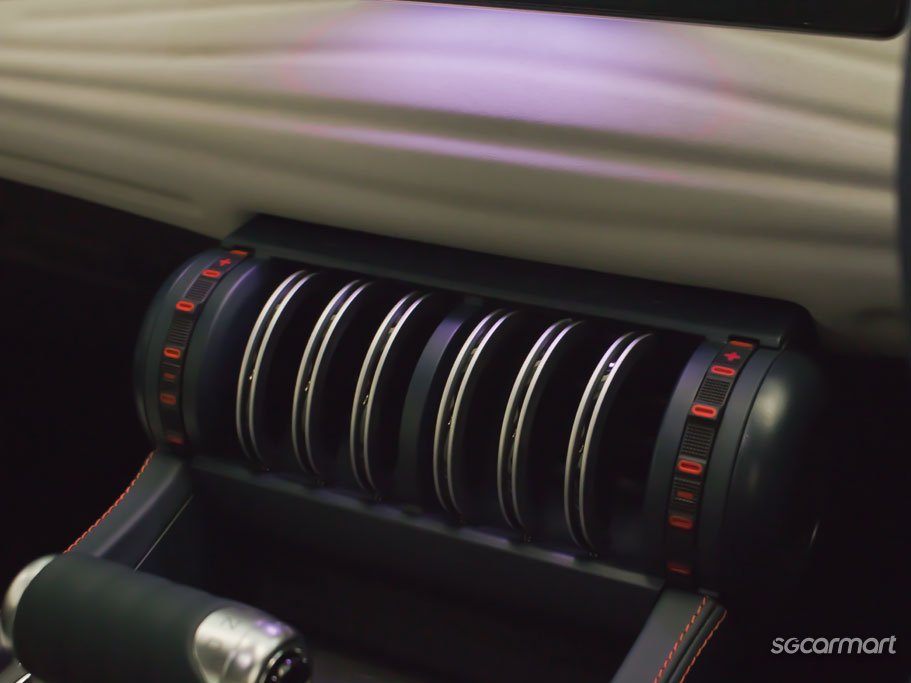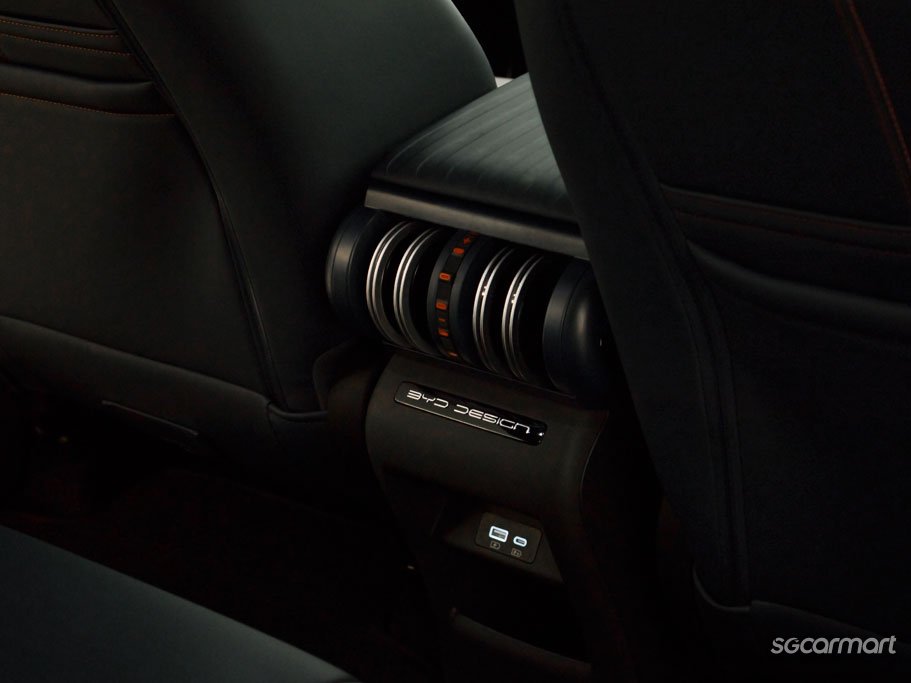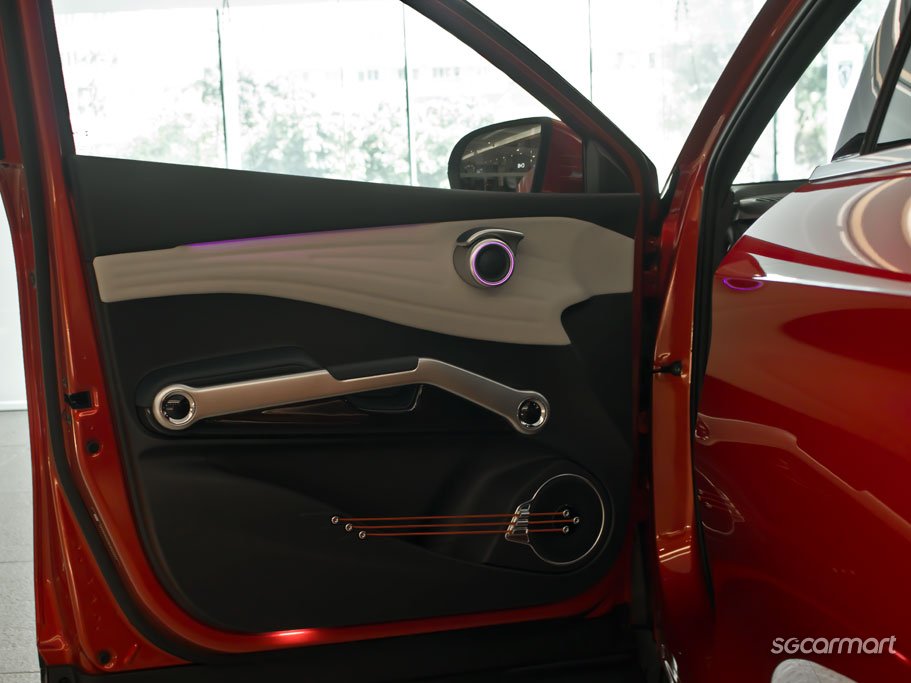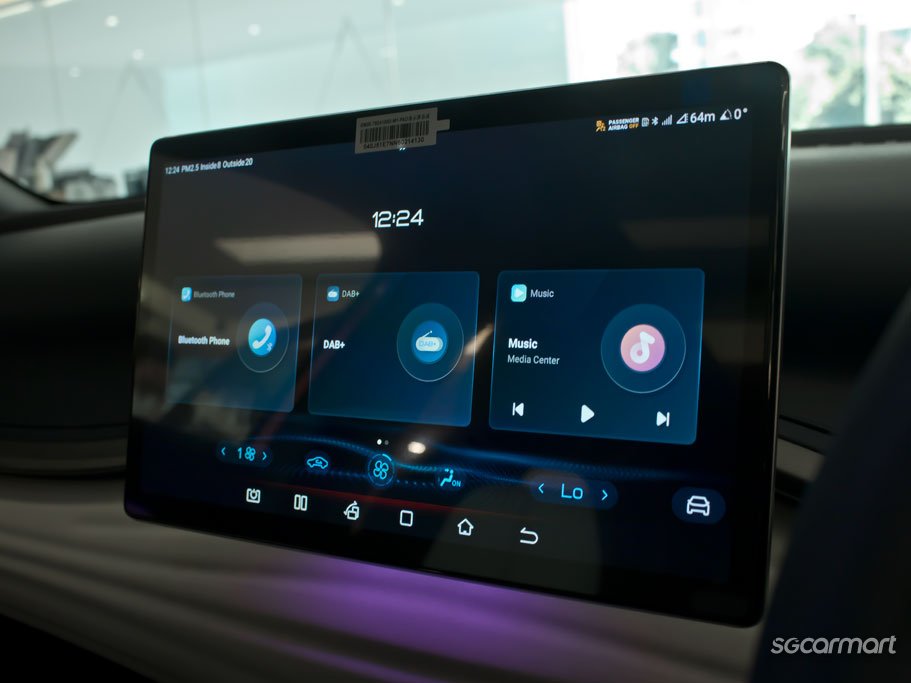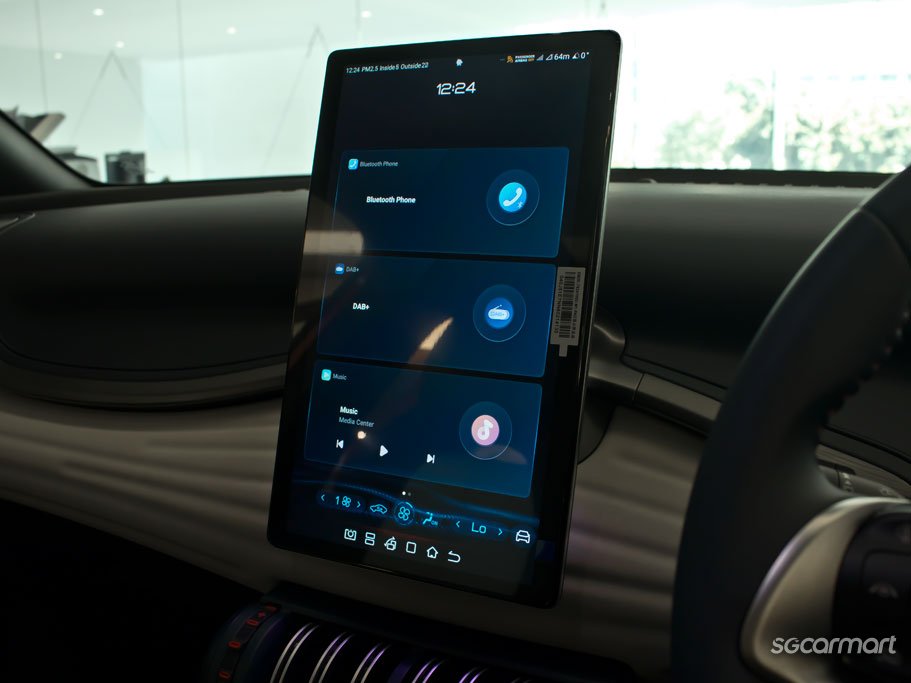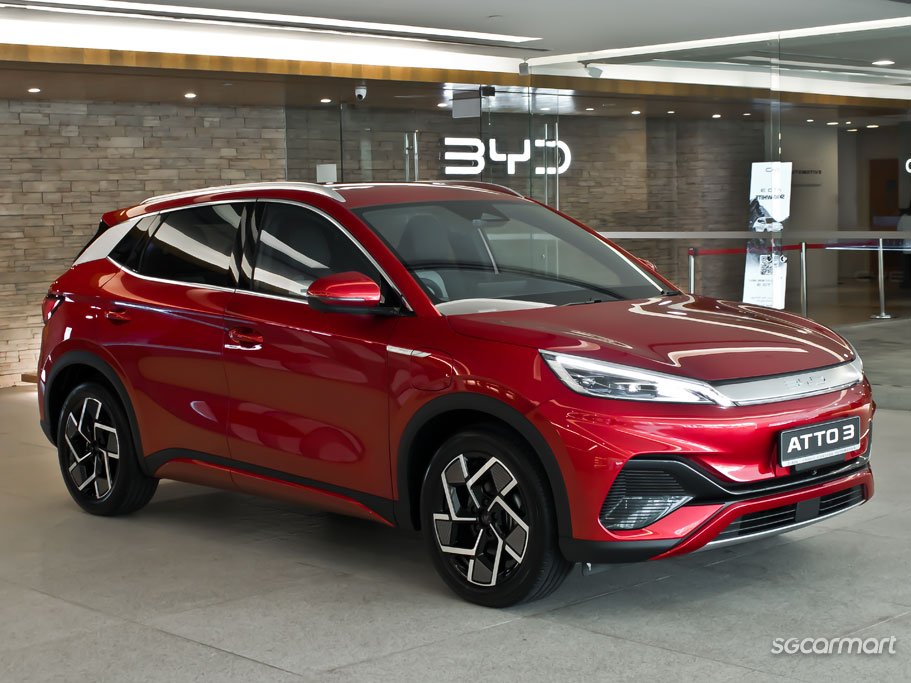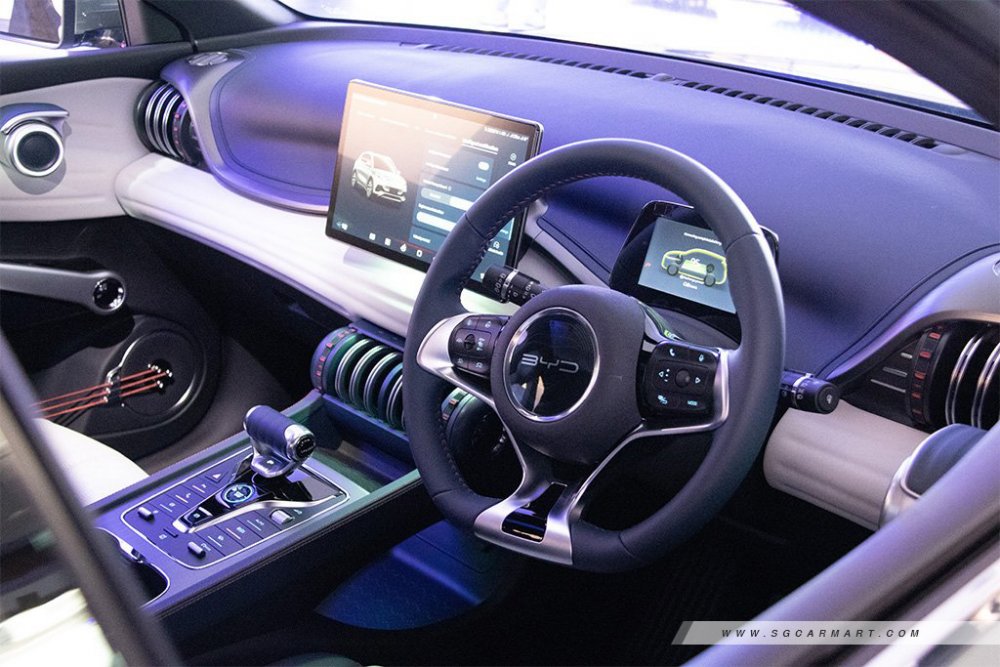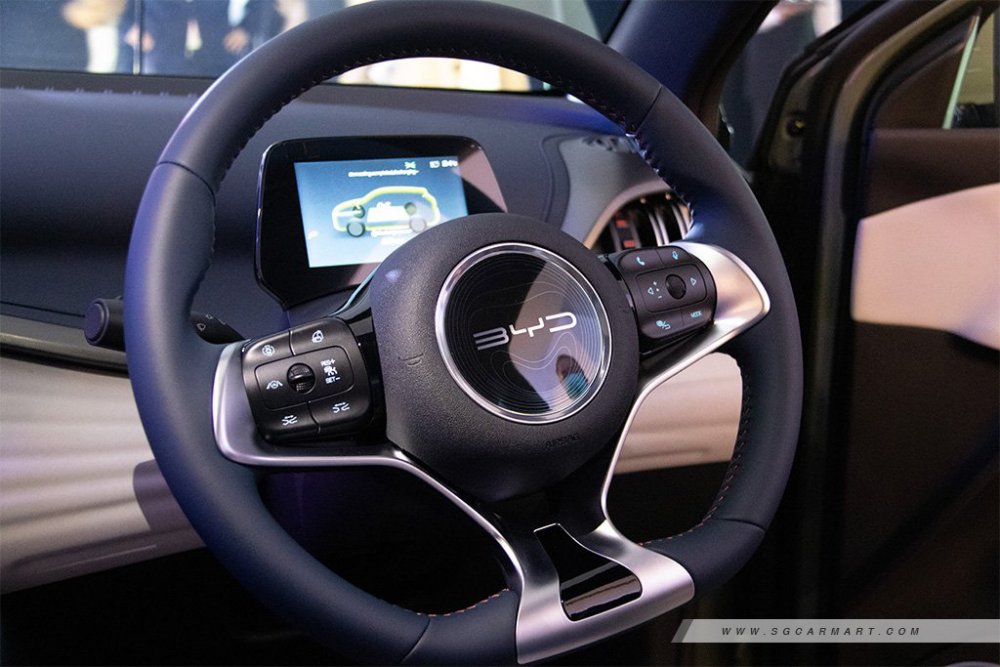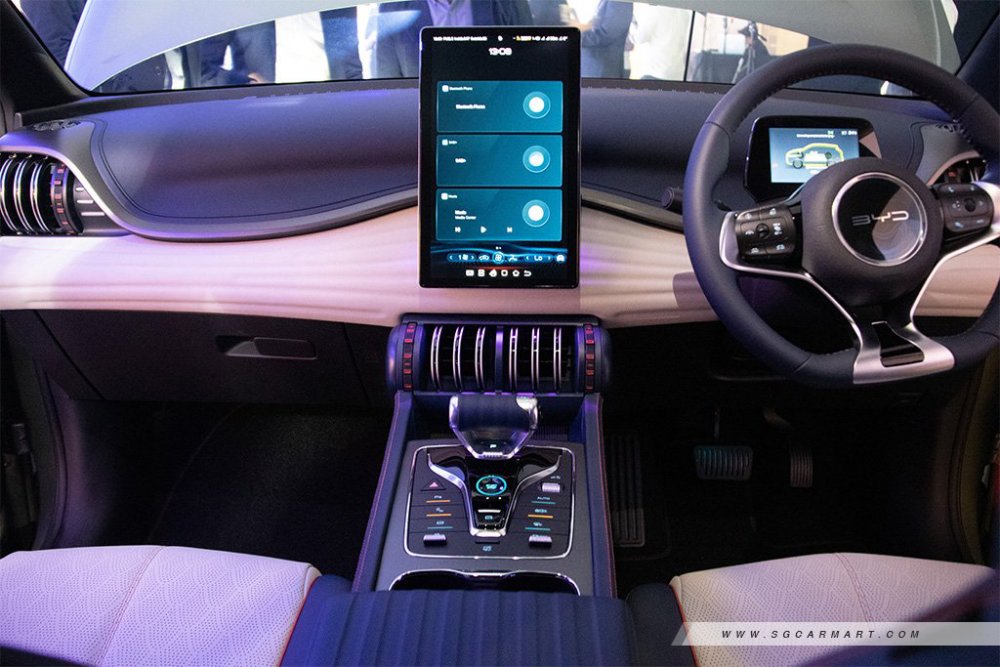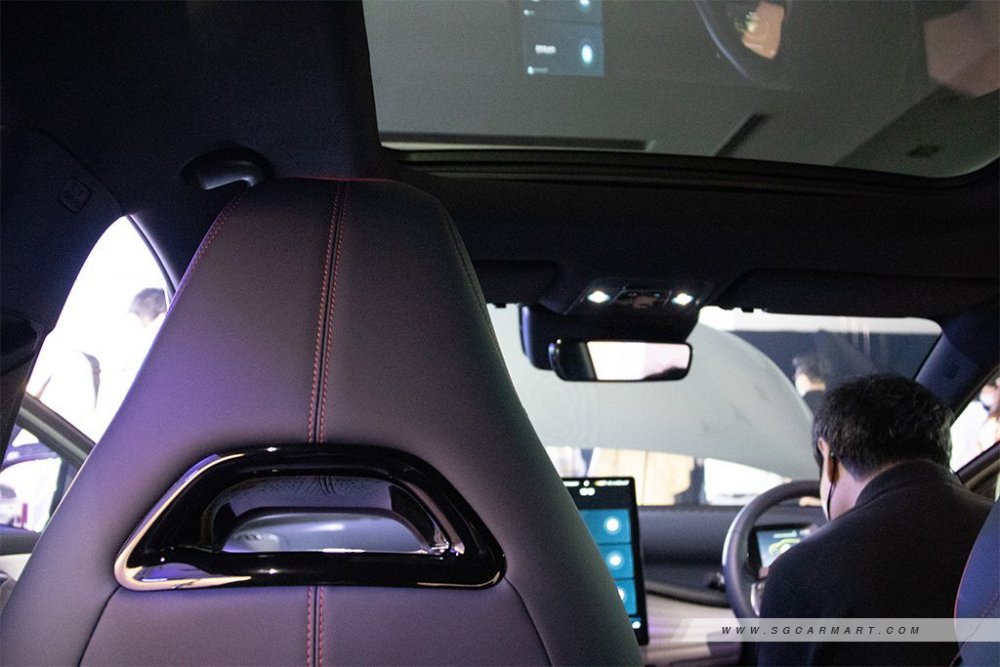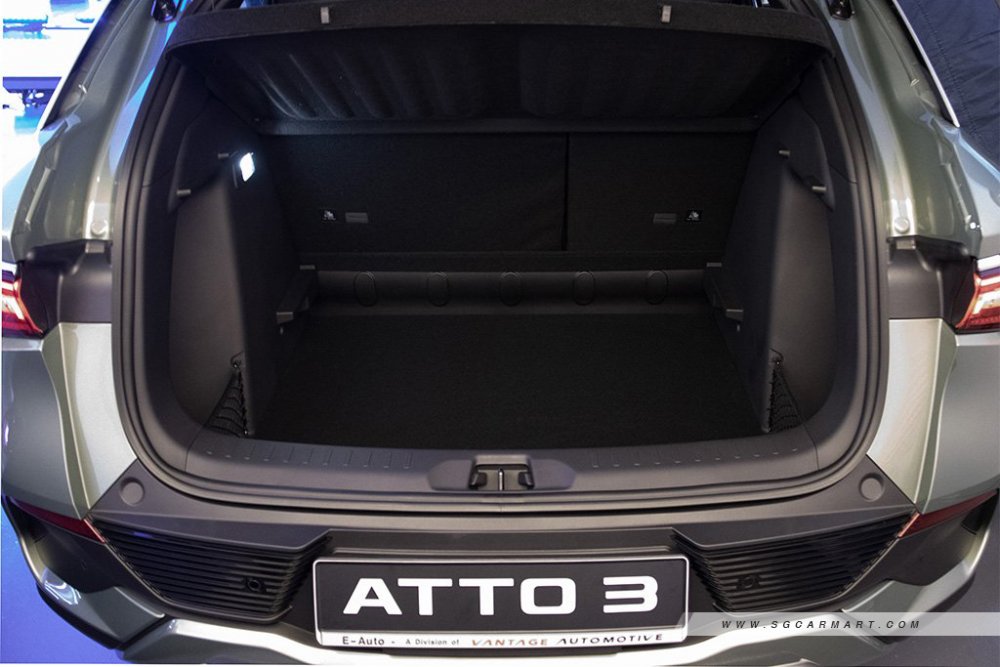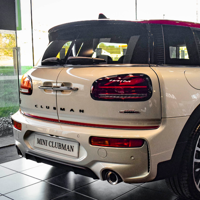Search the Community
Showing results for tags 'electric'.
-
Sgcarmart Adventures: Car Factories from Past to Present Sgcarmart is proud to present our upcoming driving tour, a curated adventure designed for car enthusiasts and community. This is your chance to meet fellow driving aficionados and drive to explore the legacy and future of innovation of car factories in Singapore. From the iconic Ford factory, a symbol of wartime resilience, to Hyundai's cutting-edge EV factory, join us on this adventure where history meets innovation at every turn! 🚘 Adventure Route: [8.30am] Sgcarmart office (New Tech Park) Kickstart your adventure and connect with fellow drivers over breakfast. Gather for a fun convoy photoshoot before we hit the road! [9.30am] Former Ford Factory Step back in time at the historic Ford factory, where you'll learn about Singapore's role in the automotive industry during World War II. [11am] Hyundai Motor Group Innovation Center Singapore (HMGICS) In this exclusive VIP tour, witness the future of automotive manufacturing at Hyundai's first global innovation hub with a car manufacturing facility. You won't want to miss out on these highlights! 💯 1️⃣ Private tour guide at Former Ford Factory 2️⃣ VIP tour of Hyundai Motor Group Innovation Center Singapore 3️⃣ Learn about the automated production of Hyundai IONIQ 5 through an immersive 3D Virtual Reality Factory Tour 4️⃣ Enjoy a thrilling EV ride on Singapore’s first rooftop Skytrack 5️⃣ Get the opportunity to test drive Hyundai IONIQ 5 or IONIQ 6 Secure your spot on an unforgettable journey through Singapore's automotive heritage and its electrifying future, visit the link for more registration details. --> REGISTER NOW <-- Spaces are limited, so act fast!
- 4 replies
-
- 1
-

-
- sgcarmartadventures
- drivingtour
-
(and 6 more)
Tagged with:
-
so after reading so many bad reviews about the civic hybrid and several good reviews about the pirus i'm wondering if 100% electric cars will be a good move in the near future, if the battery can withstand our sunny temperatures anybody got any experience to share? what is the lifespan of such batteries? the civic groups complain a whole lot about their batteries but the people who own the piruses seem to be very happy with their cars, so it does seem like a split down the middle
-
This is not another normal SUV / MPV... You are looking at the first large size EV from Skoda, with RWD setup! Skoda hasn’t built a rear-wheel-drive vehicle since the early 1990s when the 105/120/125 series of rear-engined RWD cars was discontinued to make way for the Favorit with the engine in the front driving the front wheels. The Mladá Boleslav marque is returning to its roots, but with an electric twist as the Enyaq iV will eschew the combustion engine for an electric motor. Riding on the same MEB platform as the forthcoming VW ID.4, the Enyaq will be a follow-up to the appealing Vision iV concept introduced about a year ago at the Geneva Motor Show. While it won’t look as exciting as the showcar before it, the electric vehicle should have some extra pizzazz compared to the firm’s conventionally powered SUVs, such as the Karoq or Kodiaq. One thing I’d like to add is that while the concept had some coupe influences, the production car will be more in the spirit of a tall wagon.
-
🚗⚡ Join Us for an Exclusive EV Driving Tips & Road Safety Session with OMODA x MCF HangOut! 🛣️🔋 Are you ready to take your EV driving skills to the next level? 🚙💨 Join us for an exclusive session with OMODA and MCF HangOut where we’ll cover everything you need to know about driving an electric vehicle (EV) in Malaysia 🇲🇾, from maximizing battery life 🔋 to navigating various road conditions safely 🛣️. Whether you're an EV newbie or a seasoned driver, this event is designed to provide valuable insights and hands-on experience. Event Details Date: Saturday, 30 November 2024 Time: 10 AM – 1 PM Location: OMODA Showroom, 3 Ubi Rd 4, Singapore 408608 (Parking available with limited slots 🚗) Registrants will receive a $10 Shell Petrol voucher as reimbursement. Register now! Event Highlights: EV Driving Tips for Malaysia 🌍⚡ Learn how to make the most of your EV's battery life 🔋, plan the most efficient routes 🗺️, and use charging stations effectively to ensure a smooth, eco-friendly journey. 🌱 Navigating Malaysian Roads 🚗🛣️ Gain practical advice on managing urban traffic 🚦, rural routes 🚜, and highways 🛤️ in an EV. We’ll also cover essential safety tips ⚠️ for driving in different weather conditions 🌧️☀️. Q&A with EV & Driving Experts 💬🔧 Have your burning questions about EV technology ⚙️, maintenance 🛠️, and road safety answered by industry experts. Experience Omoda EV Models 🚙✨ Get an up-close look 👀 at the latest Omoda EVs, designed for top performance, comfort, and sustainability 🌱. Explore these innovative vehicles that are leading the charge ⚡ toward greener transportation. Explore the Best Places to Eat 🍽️🍴 Discover some must-visit dining spots 🍜 for your Malaysia road trip. From local delicacies to hidden gems 🍲, you’ll be prepared to fuel up during your travels. First Peek at the J7 PHEV! 🔥🚗 Be among the first to see the stunning new Omoda J7 Plug-in Hybrid Electric Vehicle (PHEV) – a cutting-edge addition to Omoda's electric lineup! ⚡ Exciting Raffle 🎉🎁 Enjoy refreshments 🧃, network with fellow EV enthusiasts 🤝, and enter our raffle for a chance to win a 3D2N drive in Malaysia 🇲🇾! Seats Are Limited! 🎟️ Ensure your spot at this exciting event by RSVPing by 27th November 🗓️. Don’t miss this opportunity to drive smarter 🚗 and more sustainably 🌍 with Omoda. Join us for a fun and educational morning as we dive deep into the world of EVs and road safety. RSVP Now 📩 We look forward to seeing you at OMODA Showroom for an engaging and informative session! 💥 Register now!
-
- mcf
- mcfhangout
-
(and 7 more)
Tagged with:
-
20 single-deck electric buses each from BYD and ST Engineering Land Systems 10 single-deck and 10 double-deck electric buses from Yutong The buses will progressively arrive in Singapore from next year, with the final batch delivered in 2020 Source: The Straits Times
-
I started going to shell….. use GreenLots😂😂
-
Xiaomi coming soon, no joke. Xiaomi to invest $10bn in electric vehicle race Chinese phone maker Xiaomi is wading into electric vehicles with a $10bn (£7.3bn) investment over ten years. The company will be entering a fiercely competitive electric car market that also includes rivals Apple and Huawei. Xiaomi will set up a wholly-owned subsidiary with an initial investment of about $1.5bn, with the company's chief executive Lei Jun heading up the new venture. "The decision was made after numerous rounds of deliberation among all our partners, and this will be the final major entrepreneurial project of my life," he said in a statement. So far, the company has given no indication about whether it will produce budget models or target the top end of the market. There are already hundreds of companies in China jostling for a share of the world's leading market for electric cars. Xiaomi founder Lei Jun says his company’s first electric car will be an SUV or a sedan, priced between US$15,000 to US$45,000 Xiaomi’s first vehicle will be either a sedan or an SUV costing between 100,000 yuan and 300,000 yuan (US$15,300 to US$45,900), said the Chinese smartphone giant’s co-founder and CEO Lei Jun on Tuesday, shedding light on the new Tesla challenger’s multibillion-dollar venture into electric vehicles (EV). Lei revealed the details during a live-streamed video session on Douyin, the Chinese sibling app of TikTok, to promote Xiaomi products, which came a week after he announced the company’s foray into smart cars. “The first car will definitely not be a sports car or a motorhome; it’d be either a sedan or an SUV,” Lei said, adding that the plans are still at an early stage and the details are still being worked out.
-
No one talking about Aion Y Plus?
-
Officially unveiled at the Vantage Automotive Centre, the Atto 3 debuts as BYD's first-ever contender in the local compact crossover segment. Coincidentally, the SUV also marks the third passenger-car model by the Chinese maker here, following in the footsteps of the best-selling e6 and van-turned-MPV M3e. A single permanent magnet synchronous motor, paired to a 60.5 kWh Blade Battery, helps to produce 201bhp (150kW) and 310Nm of torque - apparently good for a 7.3 second century sprint. With the Blade Battery, the crossover's NEDC-rated range also clocks in at an impressive figure of 480km. Thanks to its battery architecture, DC fast charging via CCS at up to 80kW is offered on the Atto 3, bringing the battery from 20% to 80% state-of-charge within 42 minutes. AC charging at up to 6.6kW, on the other hand, will see a full recharge done in 9.5 hours. Worth noting is that the Atto 3 falls under the A1 band of the VES, allowing it to qualify for the highest ARF rebate of $25,000. The Atto 3 comes with a refreshing dual-tone interior, mixing blue and beige upholstery (in our eyes at least - the combination is called "Eclipse Blue + Hazy Grey" by BYD) with red-stitching on the seats. Shaped contours across the dash, guzheng-inspired strings along the door bins, and disc-like aircon vents all continue to distinguish the cabin of the crossover. While the driver gets a fully digital five-inch display behind the multi-function steering wheel, taking centerstage is the 12.8-inch Intelligent Rotating Infotainment Display, which can be oriented in either 'portrait' or 'landscape' mode. Another high-tech feature the car offers is the ability to be unlocked and locked via an NFC Keycard. Strangely, it appears that Apple CarPlay and Android Auto will only be available in Q4, although Bluetooth Phone Connectivity does come as standard. A BYD OS App will also debut somewhere down the line. The marque's name is spelt out boldly in capital letters too on the car's electrically-operated tailgate, which opens up to 440 litres of boot space (this can be expanded to 1,340 litres with 60:40 folding seats). Five different colours are available for potential owners of the Atto 3, including Surf Blue and Parkour Red. Test drives for the BYD Atto 3 are now being offered and the car open for booking. Local authorised dealer E-Auto has also announced that the car will launch with a special price of $178,888 (the number is supposed to be auspicious), inclusive of COE. Feature Highlights Wireless Apple CarPlay and Wireless Android Auto Wireless Smartphone Charging Inbuilt Navigation Electric Tailgate Sunroof Driver and Passenger Electric Seats 12.8" Intelligent Rotating Touchscreen 360° View Camera Adaptive Cruise Control Lane Keep Assist Lane Departure Warning Blind Spot Monitor Rear Cross Traffic Alert Front and Rear Pre-collision Warning Had the opportunity to visit Vantage before the Atto 3's official launch and I must say I left the showroom impressed with the direction BYD is going with its electric vehicles. Granted, the interior styling might be a bit tacky for some, but it is mighty packed with features. Full specs and features here.
- 296 replies
-
- 13
-

-
- byd atto 3
- byd
-
(and 4 more)
Tagged with:
-
Nice outlook, BUT there is NO rear windscreen! A big NO for me. And I find Polestar's naming convention rather confusing. This PS4 actually sit between PS2 (compact sedan) and PS3 (mid-size crossover), Swapping the name with PS3 make more sense imo. The Polestar 4 is the brand’s latest addition to the electric automaker’s growing lineup, with the new SUV slotting between the Polestar 2 sedan and the larger 3 in terms of size and price. The compact crossover adopts a stylish design showcasing key features from the Polestar Precept concept car. The Polestar 4 will be available in both single- and dual-motor layouts. The long-range, dual-motor version produces 544 horsepower and 686 Nm of torque. The crossover can hit 100 kilometers per hour in 3.8 seconds, making it the brand’s fastest production car ever. Even though the Polestar 1 had more power, the Polestar 4 will complete century sprint 60 quicker. The long-range, single-motor version, which powers the rear wheels, makes 272 hp and 343 Nm of torque. Polestar gives the long-range, single-motor variant a preliminary range target of over 483 kilometers based on the US EPA’s test procedure. The automaker fits both long-range models with the same 102.0-kilowatt-hour battery capable of 200-kilowatt DC charging and 22-kW AC. The 4 has bi-directional charging with vehicle-to-load capability and a heat pump as standard equipment. The Polestar 4 debuts with a new drive optimization function that allows drivers to select between range and performance driving modes. Range prioritizes efficiency, with the crossover capable of disengaging the front electric motor to save energy via a disconnect clutch. Performance mode sharpens the 4’s responsiveness and engages both motors at full power at all times. The dual-motor version has a semi-active suspension, while Polestar offers the model lineup with a range of 20- to 22-inch wheel choices wrapped in either Pirelli or Michelin rubber. The crossover features a low aerodynamic nose, retractable door handles, and frameless windows. It has no rear window glass, with the standard glass roof extending behind the heads of the rear-seat passengers. The Polestar 4 crossover is 4,839 millimeters long, 2,139 mm wide, and 1,544 mm tall. It has a 2,999 mm wheelbase, which makes it as big as the Audi Q7 between the front and rear wheels while being shorter overall. Safety is front and center with the Polestar 4. It has nine airbags, 12 cameras, one radar system, and 12 ultrasonic sensors. Drivers glean information from a 10.2-inch display ahead of the steering column, but a 14.7-inch head-up display is available to reduce distractions. It features a nifty “snow mode” that switches the HUD’s text color from white to yellow. A 15.4-inch landscape-oriented infotainment display runs Android Automotive OS. It has built-in Android features like Google Maps, Google Assistant, and the Google Play store. Apple CarPlay is included, and customers can upgrade to a 12-speaker Harmon Kardon sound system. However, those who upgrade to the Nappa Pack get two additional speakers in each front headrest for 16 total. Polestar will offer the sleek crossover with several upgrade packs. The Plus Pack focuses on improving the model’s tech and comfort kit. The Plus Pro Pack adds color-coded body bits, an electrochromic glass roof, and extra interior illumination. The previously mentioned Nappa Pack, which customers can select with the Plus Pack, also adds massaging seats and Nappa leather upholstery with ventilation. The long-range, dual-motor version is available with a Performance Package that includes Polestar Engineered chassis tuning. The pack also comes with 22-inch wheels, four-piston Brembo brakes, and gold details for the brakes, seat belts, and valve caps. The Polestar 4 will begin production this November in China, where it’ll launch first. The company will release more specific details for other markets in 2024, with the vehicle arriving later that same year. Polestar indicates the crossover will have a launch price of US$60,000 to start.
- 42 replies
-
- 11
-

-
.png)
-
While it look more like a facelift of the 5th gen Serena (C27), this actually a brand new model from Nissan, and it is now available in 3 drive train options: petrol only, petrol hybrid and ePower (EV). The gasoline version uses a 2.0-liter naturally aspirated engine with 150 horsepower (110 kilowatts) and 200 Newton-meters of torque offered with or without all-wheel drive and a CVT. There's also a hybrid e-Power model (2WD only) with a new and quieter 1.4-liter engine producing 98 hp (72 kW) and 123 Nm. Combined with the electric motor, the total system output is 163 hp (120 kW) and 315 Nm.
- 66 replies
-
- 15
-

-
Polestar has taken the next step in its development as the electric performance brand with the reveal of the new Polestar 2. Polestar 2 is the new all-electric fastback that brings electric performance cars to a broader and increasingly progressive audience. It offers avant-garde design and a unique customer experience in the premium compact electric segment. Polestar 2 is the first electric car to compete in the marketplace around the Tesla Model 3, with the range starting at a guide price of 39,900 euros. For the first 12 months of production, guide price of the launch edition is 59,900 euros. "Polestar 2 is our first fully electric car and first volume model. Everything about it has been designed and engineered with passion and dedication. As an electric performance brand, and through the forthcoming launch of a portfolio of fully electric cars, Polestar is determined to address the world's air quality challenges. Polestar delivers electric performance cars that are great to own and drive," says Thomas Ingenlath, Chief Executive Officer of Polestar. Polestar 2 is a premium five-door fastback with two electric motors and a 78 kWh battery capacity that will enable a targeted range of 500 km, based on Volvo Car Group's adaptable Compact Modular Architecture platform (CMA). The 27-module battery pack is integrated into the floor and contributes to the rigidity of the chassis as well as improves the car's noise, vibration and harshness (NVH) levels - road noise has been reduced by 3.7 dB compared to a traditional chassis. Polestar will answer the important question of charging Polestar 2 with a smart, convenient and extensive approach. With a connected digital solution available both in-car and on mobile devices, Polestar is setting up strategic collaborations to give Polestar 2 owners easy and hassle-free access to the world's largest public charging networks. For Polestar, performance underlies the entire driving experience. The all-wheel drive electric powertrain in Polestar 2 produces 300 kW (408 hp) and 660 Nm (487 lb-ft). This translates to a 0-100 km/h acceleration time of less than 5 seconds. The standard dynamic chassis can be enhanced by the Performance Pack that improves driving dynamics with Öhlins dampers, Brembo brakes and unique 20-inch forged wheels. Polestar's signature gold seat belts, brake callipers and valve caps complete the performance visuals. Highlighting the technology spearhead role that Polestar plays within the Volvo Car Group, Polestar 2 is one of the first cars in the world to embed an infotainment system powered by Android. The Android backbone provides a solid and adaptable digital environment for apps and vehicle functions to coexist, and brings embedded Google services to a car for the first time - including the Google Assistant, Google Maps with support for electric vehicles and the Google Play Store. Natural voice control and a new 11-inch touch screen display bring the new interface to life. Phone-as-Key technology enables car sharing and a more integrated ownership experience, as well as Polestar's connected services such as pick-up and delivery. It also allows Polestar 2 to sense the driver upon approach. Smart features like enlarged graphics in the instrument cluster allow the driver to easily see the charging status and range before entering the car. Polestar 2 can also predetermine the driver's next move to create a seamless experience with a prepared cabin and quick start sequence. Maximilian Missoni, head of Design at Polestar, comments: "We decided to bring something different to the segment. Our avant-garde design has evolved from Polestar 1 into an edgier, bolder statement. We have also designed a standard vegan interior with progressive textiles that will appeal to the forward-thinking audience who will subscribe to Polestar 2." Design-led features include Pixel LED headlights and proximity lighting which enable a unique welcome sequence, Polestar's now-signature frameless side mirrors and the unique illuminated Polestar logo, which is reflected onto the car's panoramic glass roof. In common with all Polestar cars, Polestar 2 will only be available for ordering online. The guide purchase price for the launch version of Polestar 2 is 59,900 euros with subscription pricing to follow at a later date. Pre-orders are open at polestar.com. Production of Polestar 2 begins in early 2020 in China for global markets in both left- and right-hand drive. Polestar 2 will make its first public appearance at the 2019 Geneva International Motor Show in March, and then embark on a global roadshow in Europe, North America and China throughout 2019. Polestar 2 will also be available in a network of soon-to-be-opened Polestar Spaces that will provide physical viewing and test drive opportunities. Initial launch markets include China, the United States, Canada, Belgium, Germany, the Netherlands, Norway, Sweden and the UK. Other markets are under consideration for future expansion.
- 164 replies
-
- 7
-

-
The distance cousin of Hyundai Ioniq 5. Basing on the silhouette seen below, it look like a sportier version of Ioniq 5. I like! Hyundai inaugurated the E-GMP platform dedicated to electric vehicles a couple of weeks ago with the Ioniq 5 and now sister brand Kia is about to unveil the EV6 riding on the same underpinnings. The zero-emissions model is the firm's first EV to adopt the latest design language and adopts the new nomenclature that will be used by future dedicated electric cars, as small as the EV1 and as large as the EV9. Much like the Ioniq 5, it takes the shape of a crossover and a dedicated page on Kia UK's site mentions the design is derived from the 2019 Imagine concept. It looks nothing like other production models from the South Korean brand and has the typically short overhangs you'd expect from a dedicated EV. It will be able to cover more than 483Km and will only take 18 minutes to charge the battery from 10 to 80 percent, which is the same thing we can say about the Ioniq 5. Should you be in a hurry, four minutes of charging equate to 100Km of range. 0 to 100Km/h will take only 3.5 seconds, which is quite interesting considering the quickest and most powerful Ioniq 5 of the bunch does the job in 5.2 seconds. EVs don't excel in terms of top speed and it should be the same story with the EV6, although it seems to be sportier than the Hyundai version, which is capped at 185 Km/h regardless of configuration.
- 152 replies
-
- 16
-

-
All who joined us at the latest Mycarforum hangout with the Smart #1 got the chance to learn more about one of newest brands to officially enter Singapore. After visiting the Lexus LBX in May, Mycarforum has now visited yet another crossover also perfect for taking on Singapore's streets! This time, we visited the new Smart #1, in both its 'Pro+' and 'Brabus' variants, at a swanky new pop-up showroom, located at 209 Pandan Gardens Road. This new space is set to serve as the temporary home for the newly-arrived-in-Singapore Smart brand until renovation work is completed at its permanent showroom located at level 3 of Mercedes-Benz Centre. If you're unfamiliar with the cars, here's a quick low-down on them: Sales of the all-electric Smart #1 kicked off here in Singapore only in April of 2024. The Smart #1 in its 'Pro+' variant comes with a total of 268bhp alongside a 66kWh battery, which allows you to cover a claimed 420km before its battery goes flat. The Smart #1 'Brabus', meanwhile, will please those looking for a bit more zest in their daily commute. Offering a total of 422bhp, this electric crossover will complete the century sprint in just 3.9 seconds. All this is made possible thanks to a battery which offers the same 66kWh capacity as the Smart #1 Pro+, but the greater energy consumption of the Brabus means you’ll be able to cover close to 400km before you'll need to plug the car back to a charger. And if they look a little familiar, there's a fair chance you're already seen them (other than here on Sgcarmart, that is). The cars have already visited locations including VivoCity, Jewel at Changi Airport, and Waterway point in a host of roadshows organised by Smart itself. The morning's Mycarforum hangout, however, is designed to give those interested in the cars the opportunity to get to know them better in a more exclusive setting. Those attending not only managed to catch some of the impressions of the Smart #1 from our own Editorial Manager, Mr. Desmond Chan, but also got a more comprehensive guide through the history of the Smart brand as well as the features of the cars themselves from Mr. Christopher Thenadi, Head of Operations for Smart at Cycle & Carriage Singapore. And there was more: Those in attendance also got to take part in a contest that saw them scanning QR codes pasted throughout the cars at the event. These QR codes would direct them to different questions about the cars, and those who answered the most questions correctly got to walk away from this Mycarforum hangout with various Smart merchandise! And of course, those present also got to get behind the wheel of both cars, so they could experience the generous cabin space - a product of the car's clever packaging, as well as the instantaneous torque of an electric car for themselves. Interested in joining the next Mycarforum hangout session? Be sure to look out for the notification when we've planned our next event at the Mycarforum homepage here! Those keen to try out the Smart #1 Pro+ or the Smart #1 Brabus can also sign up for a test drive with Smart here! See just what went down the rest of the morning via the photos below!
- 1 comment
-
- advertorial
- smart
-
(and 6 more)
Tagged with:
-
The new Audi Q6 e-tron (not to be confused with the larger 7 seater version for Chinese market) marks the start of a new generation of electrically powered vehicles at Audi. With a new platform, electronics architecture, charging and battery technology, as well as a pioneering design for Audi, the Q6 e-tron paves the way to Audi's all-electric future. It is the first production model based on the Premium Platform Electric (PPE). This makes the all-electric SUV with its new E3 1.2 electronic architecture the new reference for Vorsprung durch Technik. With the Q6 e-tron series, e-mobility is coming from the Ingolstadt plant for the first time. The Q6 e-tron will compete directly with BMW upcoming iX3, which is built on a dedicated platform for Vision Neue Klasse X. Audi Q6 e-tron Quattro S Line Audi SQ6 e-tron
-
SINGAPORE — Singapore will stop all new diesel car and taxi registrations from 2025, by which time eight towns will have electric vehicle (EV) charging points at all Housing and Development Board (HDB) car parks. And, by 2030, all new car and taxi registrations must be of cleaner-energy models — including electric, hybrid and hydrogen fuel cell cars — to meet the country’s goal to phase out internal combustion engine vehicles by 2040. These were among the initiatives announced by Transport Minister Ong Ye Kung in Parliament on Thursday (March 4). They are part of the Singapore Green Plan 2030 charting the Republic’s environmental targets over the next decade. Mr Ong said: “In many countries, inter-city driving is common and that causes a lot of anxiety among EV users because they are afraid of battery depletion. “But with our urban environment, Singapore is quite ideal as a test bed for the rapid adoption of EVs.” The first eight “EV-ready towns” that will be equipped with charging points at HDB car parks are Ang Mo Kio, Bedok, Chua Chu Kang, Jurong West, Punggol, Queenstown, Sembawang and Tengah. The Land Transport Authority (LTA) said that these towns were chosen because they are well spread out across the island and have many car parks with existing electrical capacity that can support charging points. The authorities will build more charging points at other HDB towns and aim to make all towns EV-ready before 2040. Under the Singapore Green Plan unveiled last month, 60,000 EV charging points will be built by 2030, more than double the target of 28,000 set last year. Giving more details on Thursday, LTA said that 40,000 of these charging points would be in public car parks and the remaining 20,000 on private premises. They will be built first at public car parks where there is spare electrical capacity, before being expanded to other car parks. Mr Ong said the authorities would focus on building slow chargers, because fast chargers require a major upgrade of almost all power substations and grid infrastructure. Right now, some fast chargers can be found at petrol kiosks, shopping malls, and industrial and commercial sites. Mr Ong said: “Where the infrastructure supports it, or where we decide to selectively upgrade the infrastructure, fast chargers can then be installed.” Efforts to build EV charging points have already started, with LTA and the Urban Redevelopment Authority launching their first tender to build more than 600 charging points at over 200 public car parks in November last year. For non-landed private residences, such as condominiums, LTA will introduce an EV Common Charger Grant to co-fund the installation of 2,000 shared chargers between July this year and December 2023. More details will be announced in the coming months. The Government will ensure that all new HDB developments will cater enough electrical capacity to support EV slow chargers at 15 per cent of their parking spots at minimum, LTA said. t will impose this requirement on new private buildings as well as buildings undergoing major redevelopment in “due course”. LTA will also launch an industry consultation later this month to determine how the private sector can take part in building more public charging points. To spearhead the new initiatives, the government agency will set up a National EV Centre to drive the adoption of such vehicles in Singapore. The centre will work with government agencies, industry partners and unions to develop new EV-related technologies and equip workers with the skills to support the presence of more EVs on the roads. In the Budget statement last month, Deputy Prime Minister Heng Swee Keat said the Government would also lower the Additional Registration Fee floor for electric cars to zero between January 2022 and December 2023. The change would make electric cars more affordable as the floor is now set at S$5,000 under the EV early adoption incentive, which kicked in on Jan 1. Under that incentive, those registering fully electric cars are given a 45 per cent rebate on the Additional Registration Fee, capped at S$20,000. The Government will also adjust road taxes for mass-market electric cars, so that their owners may pay taxes comparable to those levied on owners with internal combustion engine cars. From next year, the road tax brackets of electric cars with power ratings of 30 to 90 kilowatt (kW) and 90 to 230kW will be merged. Cars falling into this combined bracket will be subject to the present road tax formula of the lower 30 to 90kW band. With this change, electric cars owners will pay up to 34 per cent less road tax, LTA said. For example, owners of a Hyundai Kona Electric or a Kia Niro — both with power ratings of 150kW — will pay S$1,095 in yearly road taxes, instead of the S$1,447 at present. Owners of the more powerful 225kW standard Tesla Model 3 will pay S$1,500 in road taxes, down from S$2,300. These changes will also apply to owners of hybrid petrol-electric cars who now pay road taxes based on their vehicles’ maximum electric power rating. The road tax brackets for cars with power ratings of less than 30kW and more than 230kW will stay unchanged. For owners of electric and hybrid cars who have paid their road taxes beyond 2022, excess taxes paid under the existing road tax scheme will be used to offset future taxes. If the vehicle is transferred to another owner before its next road tax renewal, excess road taxes paid will offset the transfer fee. The remainder will go to the vehicle’s new registered owner.
-
Source: https://www.motor1.com/features/724805/bmw-m3-electric-horsepower-price-details/ BMW's push to electrify its lineup will take a huge step forward with the launch of the Neue Klasse platform. Set to underpin production vehicles in just two years, the electric-first architecture will make BMW's EVs more efficient, with faster recharge times and longer battery ranges. As expected, the company's electrification efforts will extend to the coveted M brand—and the iconic M3. The high-performance electric sedan is still about three years out from reality, but BMW is already hyping it up with huge promises. We know some details, like its quad-motor setup and an 800-volt architecture, but the design, output, and performance specs will be well-guarded secrets until closer to its reveal. Before we see the high-powered electric variant, BMW will introduce the standard i3 first. Until that happens, here's what we know about the upcoming electric BMW M3 sedan. What Will It Be Called? Late last year, a trademark filing surfaced for the name "BMW iM3," which many speculated could be for the performance variant. But BMW M CEO Frank van Meel was quick to refute the speculation, saying that the company would "never" use the letter "i" on an M car. However, BMW recently announced it will drop the letter "i" from its gas-powered vehicles, which denotes fuel injection. Instead the letter "i" will be used for EVs, which means we should see models like i320, i330, and i340 preceding the electric M3. What Will It Look Like? BMW previewed the new platform with the Vision Neue Klasse concept. The sedan featured a fresh design language with a broad, illuminated kidney grille encompassing the headlights and slim taillight housings at the back. Its long hood and short rear deck looked sporty enough for the sedan, but it’s unclear how much of the concept’s styling will carry over to production. The new platform certainly allows the company to reset its styling ethos. Either way, we expect BMW M to differentiate the M3 from the i3 with unique wheels, fascias, and interior trim. This rendering imagines what the electric BMW M3 could look like, with a more aggressive "grille," larger diffusers front and rear, and additional sporty accents in line with the current gas M3. What Platform Will It Ride On? The electric BMW M3 will ride on the Neue Klasse platform, BMW’s latest vehicle architecture designed specifically for battery-electric vehicles. It integrates the batteries into the car’s structure, which features an 800-volt architecture and fast charging at up to 270 kilowatts. It can accommodate battery sizes from 75.0 to 150.0 kilowatt hours, which can add up to 30 miles of range per minute when charging. The new underpinnings will also bring about the automaker’s sixth-generation electric drive technologies and new cylindrical batteries with up to 30 percent more range than today’s BMW EVs. They will also be up to 50 percent cheaper than the current fifth-generation batteries and should lower the charging times from 10 to 80 percent by around 30 percent. What Will Power It? The electric M3 will have four electric motors and all-wheel drive, one at each wheel. While the Neue Klasse platform can make up to one megawatt of power—or 1,341 horsepower—it’s unclear if the automaker will unlock all that potential for this particular M model. The gas-powered BMW M3, which should remain on sale alongside its electrified sibling for a few more years, makes 473 horsepower in its most basic form. The latest rumors suggest that the electric M3 will make around 700 hp, with the company planning regular and Competition variants. BMW is also considering developing a dual-motor, rear-wheel-drive variant that’ll deliver a different driving experience. It might also make an electric M3 wagon, but we’ll have to wait for the potent new lineup. When Will It Debut? BMW still has to reveal the Neue Klasse-based 3 Series sedan and the iX3 crossover, neither of which will arrive until 2026. The electric M3 will debut sometime after the standard sedan breaks cover, giving us our first look at what the battery-powered M3 could actually look like. When Will It Go on Sale? Performance fans will have to wait for this one to arrive. BMW’s first Neue Klasse model will be the iX3 crossover and the i3 sedan, which is supposed to begin production next year. Those should go on sale in the US sometime in 2026, which puts the electric M3 reaching dealers sometime in 2027. How Much Will It Cost? If the electric M3 will "beat everything" as BMW claims, it might have a price that reflects those aspirations. However, it’s too early to know for sure. The entry-level 2024 BMW M3, with the 473-hp, twin-turbocharged inline-six engine, starts at $76,995 (all prices include the $995 destination charge). The 503-hp M3 Competition costs $81,195. The possibility of the electric M3 making over 1,000 hp would put it on par with today’s gas-powered supercars and in competition with other EVs like the aging Tesla Model S Plaid, which currently costs $89,380 and makes 1,020 hp. But that seems like a stretch for the new M3 right out of the gate. BMW is likely reserving that amount of power for something even more special. The most powerful EV in BMW’s lineup today is the 2024 i7 M70 sedan, which delivers up to 650 hp. It also costs $169,495 compared to the i5 M60, which starts at $85,095 and makes 593 hp. Those numbers can’t predict the future, but they do show how attainable horsepower can be in an EV, so there is the real possibility that the ultimate M3 with 700 hp could cost around $100,000 or less to start. We’ll have to wait and see.
-
The BYD eT3 compact van has had a large impact on how businesses do their logistics here. And it's now set to develop an even larger presence still. The BYD eT3 has been the best-selling electric van here in Singapore for the past four years despite facing significant challenges including the reduction of the CVES rebate, high commercial vehicle COE price premiums, and sustained competition from rival brands. To achieve such a feat, there must be more behind the eT3 than its clean drivetrain and compact dimensions. So, we decided to take one example out for an afternoon to find out why it has remained the favourite among logistics firms and tradesmen alike all these years, and even learnt about a few future developments that owners of the van can look forward to! Right-sized for businesses in Singapore Chief priority for any business owner shopping for a commercial vehicle is cargo-carrying ability, and those looking at the BYD eT3 certainly won't find it lacking. Despite measuring in at just 4,460mm long and 1,720mm wide, the BYD eT3 offers a generous 3,800 litres of cargo space. And these compact exterior dimensions also mean that it is ideally-sized for any business here in Singapore, allowing it to be comfortably driven within the tighter streets of our island's cultural districts, and to find parking space when loading/unloading cargo, even at the most challenging worksites. And there's one added benefit to those that opt to conduct their business with the BYD eT3. With the all-electric van coming in at 1,875mm tall, those who need to do deliveries to residential addresses will have no difficulty entering most multi-storey carparks! Loved by drivers and businesses alike But of course, it's not just the exterior dimensions that has won the eT3 its many fans. Those who spend long hours on the road are sure to be impressed with the BYD eT3's ergonomic cabin and generous legroom engineered for driver and passenger comfort, even after just one quick drive. Powered by a 134bhp electric motor that delivers a total of 180Nm of instantaneous torque, drivers of the BYD eT3 can look forward to an easier driving experience, even when faced with start-stop traffic. With its whisper-quiet electric drive, drivers also won't be as fatigued in this van compared to a diesel-powered one. This not only means safer journeys, but also a more alert driver - essential when there's also plenty of different invoices and receipts to handle and to ensure that the client doesn't end up with the wrong packages! You won't have to shy away from making deliveries across the island with the BYD eT3 either. You get BYD's blade battery in the eT3, with a total of 44.9kWh of capacity, which allows you to travel up to 280km with each charge. And with a peak charging speed of 50kW when at a direct current charger, no driver will have to wait long at a charging station to top up the eT3's battery. Those who will spend all day on the road will also be pleased to note that this blade battery comes with a Proprietary Battery Management System, which ensures that every charging session is done at safe temperatures and prevents dangerous battery swelling. Supported by a strong aftersales network But it's not just the strengths of the BYD eT3 that have ensured its popularity here. The van is also supported by a strong aftersales network that ensures that any business that relies on it will see minimum downtime. Servicing the BYD eT3 is ST Engineering Mobility Services, which operates a 6,500sqm workshop staffed with more than 40 technicians trained to service both electric and combustion-powered vehicles. Complete with a spray booth and its own mobile team, ST Engineering Mobility Services is a one-stop solution for any vehicle services a business may need, from regular maintenance to accident repairs and warranty claims. All this, of course, comes on top of the promotional servicing package offered with the eT3, as well as its battery warranty of eight years/500,000km - making it a truly dependable option for those that don't want interruptions in their business operations. And plenty more to come Interested in giving your business a little boost? There's no need to spend time second guessing just what sort of logistical support your business needs as ST Engineering Mobility Services will soon be opening a dedicated eT3 showroom. Those looking to start their own businesses can see just how they'd like the cabin of the van as their second office, while fleet purchasers can see more of the van's charging capabilities and cargo space for themselves, even before committing to any downpayment. And you'll soon be able to get your van with a host of advanced driver assisted systems as well, all to ensure that you and your drivers get another layer of protection when they're out on the road. Find out more about the BYD eT3 here, or contact ST Engineering Mobility Services at their sales hotline at 6660 3991 to set your business logistics on a cleaner and greener path!
-
YouTuber Alex Choi attended a Tesla meeting where owners showed what modifications they made to their cars. Everything ran smoothly, and everyone was enjoying their time there. But the night ended in a completely different matter. Choi was approached by a Tesla owner that, out of the blue, wanted to show him where David Dobrik (a.k.a Borat) jumped his EV from Elon Musk’s company. Since this was a friendly encounter and a curious invitation, he accepted. What he didn’t expect was to see this owner attempt a jump in that exact spot with his brand-new Tesla Model S. The YouTuber even says that the driver of the flying and now totaled Tesla attempted this on its own. Moreover, he’s done without any practice or test run beforehand. Naturally, a crowd gathers, and everyone starts filming. For some reason, the owner of the acrobatic Tesla violently accelerated, and the jump instantly became a very short flying lesson. The outcome, well… You can see it for yourself. The car was destroyed. What’s sad is that other innocent owners had their cars damaged as well because the impact on the ground was so brutal. Fortunately, nobody was seriously hurt. Apart from the new Tesla and some other damage to public property, nothing else went wrong. Still, the video is further proof that Model S vehicles are safe and can protect even the most adventurous drivers. https://www.autoevolution.com/news/brand-new-tesla-model-s-jumps-50-feet-into-the-air-everybody-s-speechless-184385.html Great conclusion right there lol.
-
Huawei has just unveiled the Seres SF5 - an electrified crossover, which will be sold at Huawei’s flagship stores in China. OK to be precise, the vehicle is not designed entirely by Huawei as it’s actually an updated version of the existing SF5 crossover, which made its original debut two years ago in Shanghai. Huawei says it has helped automotive company Seres with the development of the powertrain, which consists of a 1.5-liter gas engine and two electric motors. The combined output of the system is reportedly about 550 horsepower (410 kilowatts), which should be enough for a 0-62 miles per hour (0-100 kilometers per hour) acceleration in just 4.7 seconds. More importantly, Huawei promises the plug-in hybrid can travel up to 112 miles (180 kilometers) on purely electric energy, though it’s important to note that this is measured by China’s somewhat generous test cycle. With the battery fully charged and the fuel tank full, the SF5 should be capable of a range of over 621 miles (1,000 km) in “extended range mode for long distance travelers.” Huawei’s input is probably more visible inside the cabin where there’s a large tablet-style screen for the infotainment system. The company says it has paid special attention to the crossover’s audio system, which consists of 11 sound units to deliver “opera-like sound quality.” Another interesting feature of the SF5 is the vehicle-to-vehicle charging function, which can power other vehicles or external devices such as induction cookers, stereos, and other camping equipment. "This exciting announcement sets a precedent for both the consumer electronics industry and the new energy vehicle industry,” Richard Yu, Executive Director at Huawei, commented. “In the future, we will not only provide leading smart car solutions to help partners build better intelligent vehicles, but also help them sell those vehicles through our retail network across China." Speaking of China, Huawei is already accepting orders for the SF5 in the People’s Republic with prices starting at 246,800 RMB (~S$50K at the current exchange rates) for the 4WD model and 216,800 RMB ($44K) for the 2WD variant.
- 25 replies
-
- 16
-

-
Source: https://www.lowyat.net/2022/270902/smart-1-official-launch-specs/ Seven months after Concept #1 was revealed in Munich, the revitalise smart Automobile Co. has officially launched its first production model for the company’s new all-electric era, the smart #1. In case you’re wondering, the actual way to pronounce the EV’s name is “smart HASHTAG one” according to the official launch video. In case you are not familiar with the current iteration of smart Automobile Co., the company is no longer a full subsidiary of Mercedes-Benz but has been transformed into a joint venture between the company and Geely. As such, the Stuttgart giant is responsible for the design of the new smart #1 while the engineering portion is being handled by its Hangzhou counterpart. Exterior-wise, smart has generally retained the design lines of its Concept #1 for the production model albeit with some differences such as smaller 19-inch wheels, a less extravagant glass roof, and rear doors that still have front-mounted hinges. Measuring 4270mm long, 1822mm wide, and 1636mm tall alongside a wheelbase of 2750mm, the 1,820kg SUV also features concealed door handles and frameless doors together with up to 411L boot space and a 15L front boot. Alongside customisable ambient lighting, the smart #1 is equipped with touchscreen infotainment & vehicle control system that features a 12.8-inch Full HD display while the driver has also been provided with a 9.2-inch Full HD digital instrument cluster and a 10-inch Head Up Display. For the Premium and Launch Edition variants of the EV, there is also a 13-speakers audio system from Beats. Featuring a 200kw rear-wheel-drive setup that produces 272PS of power together with 343Nm of maximum torque, the SUV has a maximum speed of 180km/h. Through the car’s 66kWh battery, smart claimed that its new SUV is able to reach a maximum range of between 420km to 440km according to the WLTP standards. As always, charging times depends on the type of charger used with the smart #1. According to the company, the SUV can be charged from 10% to 80% in under 3 hours with a 22kW AC charger or in under 30 minutes when using a 150kW DC charger. Despite the official announcement today, smart didn’t reveal anything regarding the release date or the pricing for its new all-electric compact SUV. While Proton Edar has recently signed a deal to bring smart EVs into Malaysia, the company also has yet to make any official announcement regarding the availability of smart #1 for our market.
-
RWD Hot hatch EV..... I am almost ready to accept the other issues of EV and open my cheque book... https://www.carscoops.com/2024/04/byd-ocean-m-hot-hatch-concept-previews-this-summers-corolla-sized-ev/
-
This compact electric SUV will be even smaller than the XC40, with an estimated dimensions of 4.2m (L) x 1.8m (W) x 1.6m (H). Design wise, the line between products from Volvo and Polestar is getting blurry, and can see that the rear windscreen is very narrow (by SUV standard), again compromising practicality for aesthetic appeal...
-
Volvo Cars bets on electric vehicles Volvo Cars is only going to sell electric vehicles by 2030, the Swedish firm has said. It will phase out all car models with internal combustion engines by then, including hybrids. The carmaker is also planning to invest heavily in online sales and simplifying its products. It is trying to capitalise on growing demand for electric cars, including in China, which is already one of its biggest markets. Carmakers are also responding to pressure from governments around the world to beef up their electric car plans. New cars and vans powered wholly by petrol and diesel will not be sold in the UK from 2030, for example. "To remain successful, we need profitable growth. So instead of investing in a shrinking business, we choose to invest in the future - electric and online," said chief executive Hakan Samuelsson. Its online push means customers will be able to order cars to their own specification online, but also through a dealership. Volvo will not be investing in cars with hydrogen fuel cells, as it does not think there will be enough demand from customers. There is also a question mark over hydrogen's availability in comparison with charging points for electric cars, a spokesman said. Volvo previously announced that by 2025, half of its sales would be fully electric, with the rest being hybrids. "There is no long-term future for cars with an internal combustion engine," said Henrik Green, the firm's chief technology officer. In February, Volvo abandoned plans to merge with Chinese car giant Geely. But the two companies said instead that they would form a partnership to make components for electric cars that would be used by both firms. Global carmakers continue to pursue alliances to spread the cost of the transition to electric cars, tougher emission rules and autonomous driving, as well as pooling expertise and resources. In January, shareholders approved a merger between Fiat Chrysler and France's PSA Group, creating the world's fourth biggest carmaker. The new group, Stellantis, would be able to "bet big on new innovations in electric, connected and autonomous vehicles", analysts said at the time. https://www.bbc.com/news/business-56245618
-
Designed by ChangAn Mazda JV, this model is currently and likely be for the Chinese market only. Sitting on 19-inch aero wheels, the Mazda EZ-6 has a large panoramic glass roof and frameless doors. Reports from China indicate the electric/plug-in hybrid sedan is based on the ChangAn Deepal SL03 but pushed upmarket with a fancier interior. The cabin doesn't appear to have much in common with the Mazda products sold globally, which would explain the Chinese connection. It does seem like a nice place to be in, and that full-length "floating" center console is interesting. The Mazda EZ-6 gets a rear-wheel-drive setup as an electric model. It has a perfect 50:50 weight distribution and a multi-link rear suspension. The unspecified battery pack is good for 600 Km of range per the China Light-Duty Vehicle Test Cycle (CLTC). The plug-in hybrid can cover 1,000 Km before running out of gas and battery juice. As for size, it's 4,920 mm long, 1,890 mm wide, and 1,483 mm tall. That makes it slightly bigger than the outgoing 6. Speaking of which, Mazda has already ruled out replacing the 6 we all know with a new generation on the company's RWD platform with inline-six engines. For now, that architecture is exclusively used by four SUVs: CX-60, CX-70, CX-80, and CX-90.

_970x430.jpg.4d2609577b125b13a4c30f3146685fa4.jpg)





